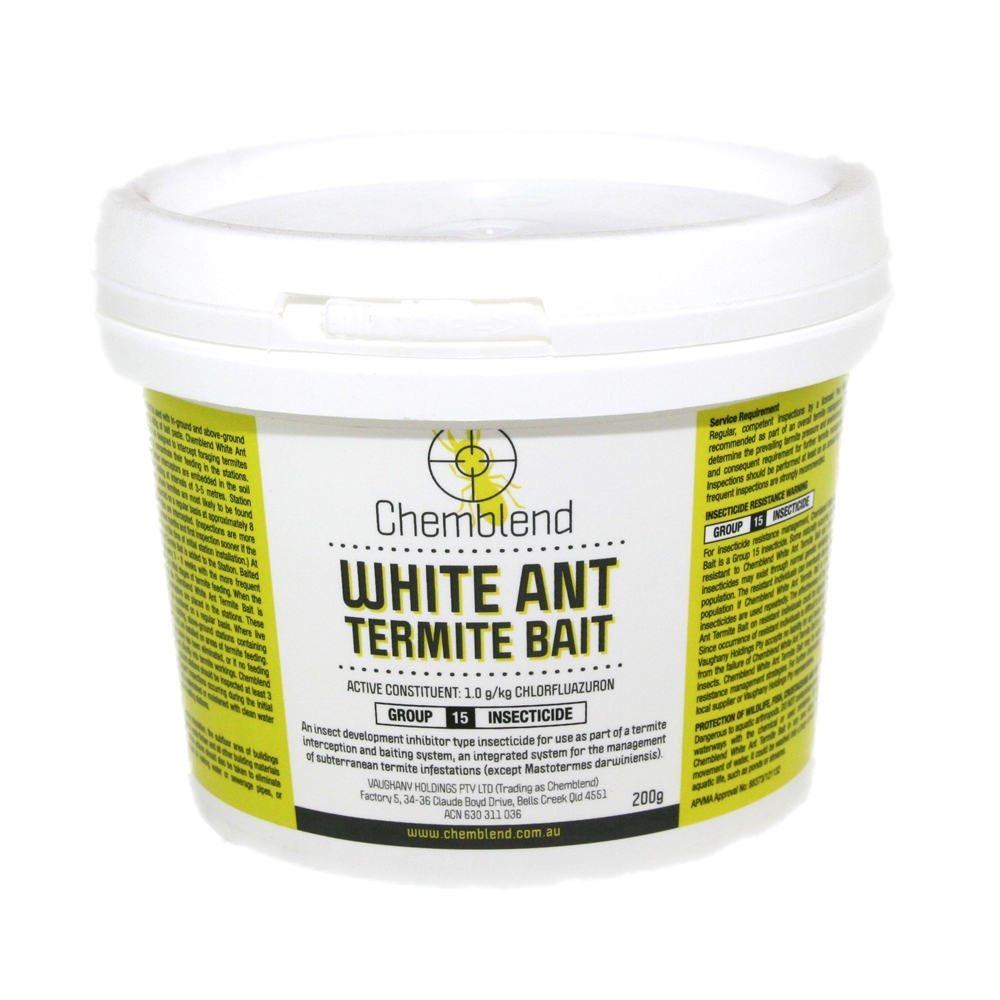Description
Chemblend White Ant Termite Bait
Active Ingredient: Chlorfluazuron @ 1g/kg
Similar Or Comparable To: Nemesis Termite Bait (PCT), Colony Killer Termite Bait (Termi-Fix) & SuperWay White Ant Termite Bait (Pooma Fertilizers)
Chemblend White Ant Termite Bait is a DIY “Back to the Nest” Termite Treatment.
Chemblend White Ant Termite Bait is an approved insect development inhibitor type insecticide and can be used as part of a termite interception and baiting system or directly into termite workings. It is suitable for all termite species except the Mastotermes darwiniensis species. It has been specifically approved by the Australian Pesticide and Veterinary Medicines Authority (APVMA). The active ingredient in the Termite Bait is taken back to the nest whereby it spreads through the nest over a short period of time, inhibiting the growth of the termite colony and eventually eliminating the nest.
The White Ant Termite Bait is based upon proven insect growth regulator technology. Chlorfluazuron, inhibits the ability of the individual termites to synthesize chitin. Termites moult, that is they shed their exoskeletons because they cannot reproduce chitin, they are unable to replace this skeleton and thus perish. The termite colony loses whole generations and collapses as a consequence.
What Should You Do If You Discover Termite Activity?
If you discover termite activity, don’t panic, do not disturb the termites, or reach for the spray can, (you will only kill those termites which come into contact with the spray not the colony).
Baiting Live Termites:
The Chemblend White Ant Termite Bait can be immediately placed onto or into timbers where termites are found feeding, using above ground stations. The preferred timber interceptors to attract and check for termite activity are from sapwood of softwoods, for example hoop, slash and radiata pines. The termites quickly feed on the Chemblend White Ant Termite Bait, taking it back to the nest. The termites cannot detect that the bait is slowly affecting their ability to grow and develop. The insect growth regulator active ingredient – Chlorfluazuron – also stops the termite colony being able to reproduce. Chemblend White Ant Termite Bait is replenished or refreshed periodically in order to facilitate bait uptake. Active stations are regularly inspected and replenished as required approximately every 3 weeks. The termite colony loses whole generations of replacement members and gradually declines and finally collapses. The effects of the Chemblend White Ant Termite Bait are visible and can be tracked. This means that the termite colony elimination can be reliably determined. The termite’s natural habits, food preferences, energy saving and feeding behaviour are all used against the colony.
Detecting & Aggregating Termites:
If live termites cannot be located, special inground monitoring stations can be placed either in the soil, through concrete or under pavement at strategically important points around a building. These stations can be inspected on a regular basis with the inspections tailored for intervals of approximately 8 – 12 weeks or so. It is strongly recommended that regular 3 monthly or 6 monthly house inspections are also carried out by your professional pest manager if your house/property is at moderate to high risk. The preferred timber interceptors to attract and check for termite activity are from sapwood of softwoods, for example hoop, slash and radiata pines.
Termite Monitoring:
When the termite colony has been eliminated, the bait is removed and new timber interceptors are put into place. The monitoring system then continues to provide an opportunity to detect termites foraging in the soil close to structures and in many cases before serious levels of damage occur. The Chemblend White Ant Termite Bait system can take several months to completely eliminate a termite colony. However it can drastically reduce the rate of wood consumption by the colony within 4-6 weeks after the colony begins to consume the termite bait.
Pack Sizes: 200gm, 500gm, 1kg & 2kg.
Registrant: Vaughany Holdings Pty Ltd (APVMA #: 88373)












What others are saying
There are no contributions yet.